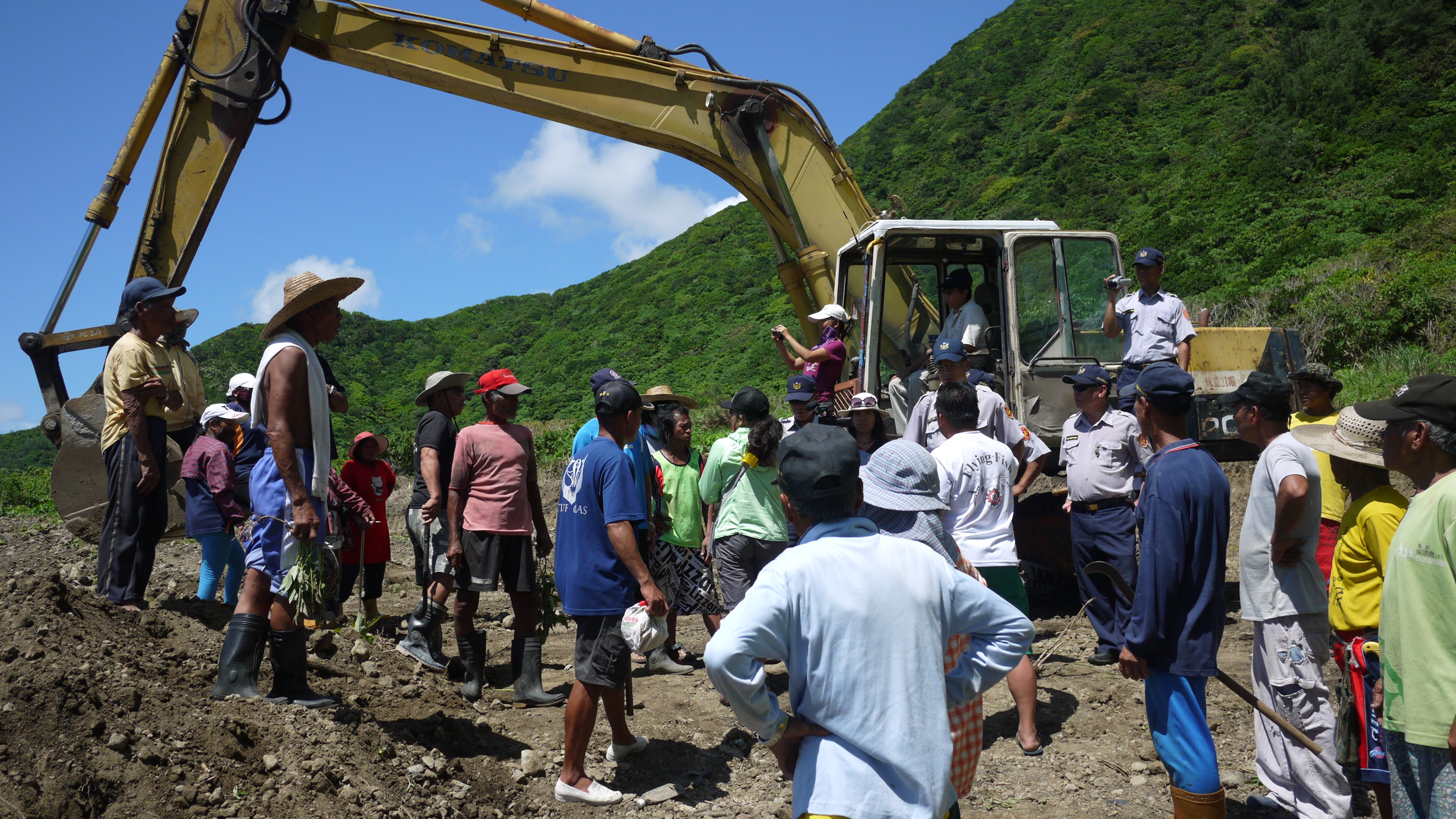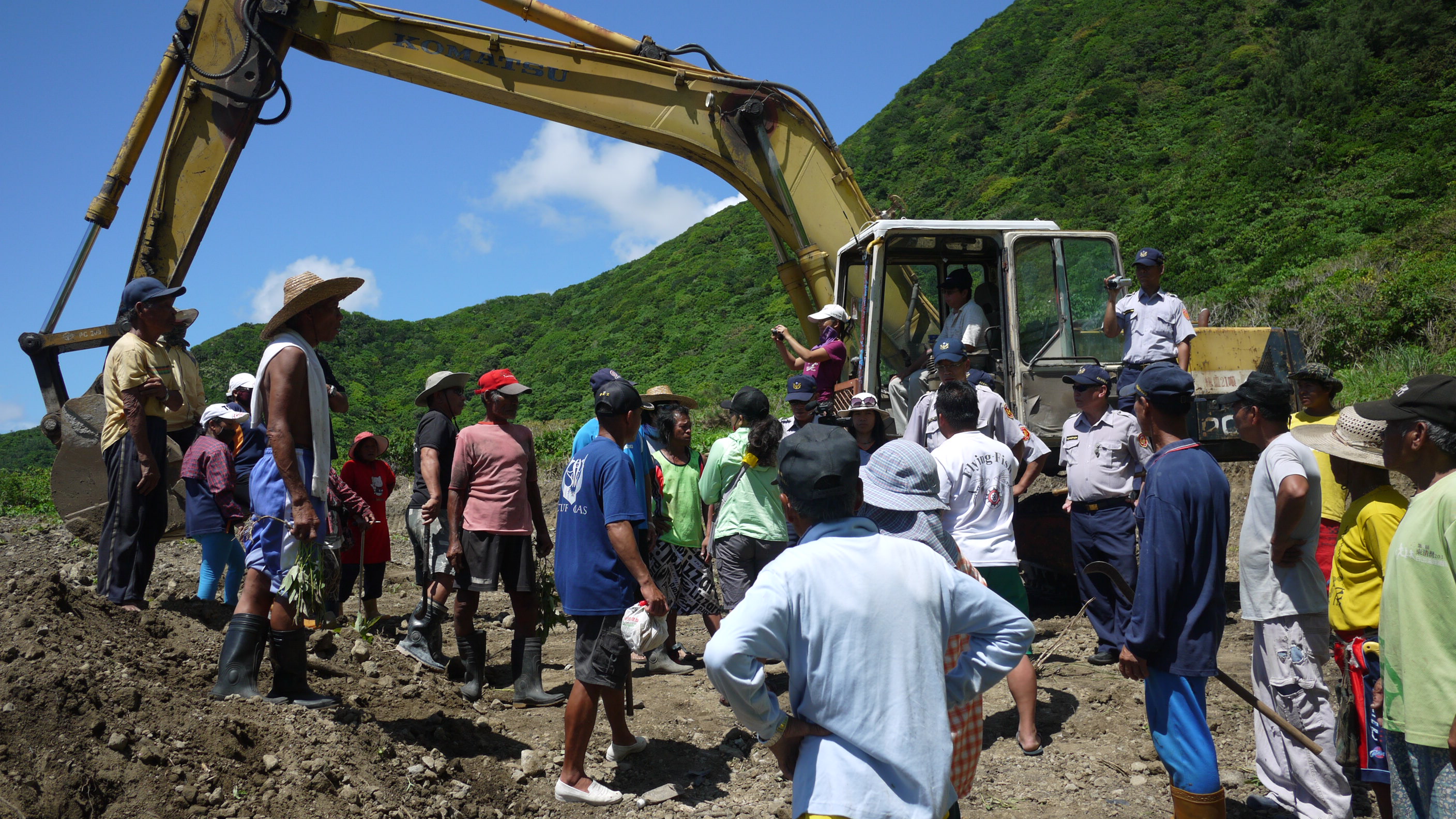Last week, I(Emily) visited Lanyu Island to share about Gangjeong struggling stories and the idea of inter-island solidarity for Just Peace. One Tao friend says “when thinking of Tao people’s struggling for more than 3 decades against nuclear waste dump depository which was successfully built up in Lanyu as they lied to the islanders that it’s a fish can factory, I especially feel for the Gangjeong’s situation”

ps. In the end of this article, there is the simple history of Lanyu. You can see brief Lanyu’s history under ROC’s governance.
Now the DongChing tribe in Lanyu faced an emergency situation. The government and the construction company are working together to take over the “traditional area” of Dongching tribe’s land in Lanyu island to build a “temporary” Ready-mixed concrete factory without any discussion with tribal Association.
As soon as the villagers of Dongching tribe found out the excavator digging the traditional area of DongChing tribe , the protest has started and the tribe self-help association was formed for long-term resistance.
Now the government has send some policemen to the island to enforce the work for building up a Ready –mixed concrete factory, and today, on June 21st, more police are expected to be dispatched to Lanyu.

Islanders reject Lanyu to be a Concrete Island!
Last summer, a typhoon seriously attacked Lanyu, so for lots of public re-construction after the natural disaster, 2 “legal” Ready-mixed concrete factories are declared to be needed although in the small Lanyu island, there’re already 3 “illegal” Ready-mixed concrete factories.
The islanders request the government not to destroy and pollute more land in the small island but to facilitate the existing 3 Ready-mixed concrete factories in Lanyu to be legalized and then use the legalized 3 factories for construction.
It’s a reasonable request and shows the love to the environment and culture from the locals. But the government insists they have gone through the legal process to do this work which is not true.
- The previous information was not given to the tribe, and a public hearing and negotiation was held only after the protest.
- No sign was ever set up 30 days before the construction.
- The mayor of Lanyu lied that the Land Use proposal in DongChing was agreed by the Land Review Committee. The Land Review Committee denied this saying.
- Avoiding the Aboriginal Basic Law and Aboriginal Reserved Land Management Measure by saying it’s not a “land development” action but actually the construction company will use the Ready-mixed concrete factory to build the facilities for tourism industry.
The Tribe Traditional Area is ROC’s land? No!
The mayor insists the owner of the land is Republic of China, there’s no owner, so nothing wrong to use this land. It is a shameful thing to declare especially from a Tao officer as everybody knows that the land of Lanyu was owned by Tao people traditionally until the Japan and Chinese colonizers came to the island with guns, and the Chinese government applied an unjust land dispossession policy to lots of private and common land of the tribes.
That there’s no single person who owns this land doesn’t mean there’s no owner. This “Traditional Area” of DongChing tribe is owned collectively by the tribe. The harvest like dry taro from the collective farming land is for the use of tribal festival. It contains an important cultural meaning.
Now the tribe people are staying, confronting the workers and police, in the site to protect their traditional area. The island is small and far from the main Taiwan Island. It’s hard to reach soon even when Taiwanese people want to go the site to support.
Please help Tao people to feel not alone.
- You can make a complain call to the Taitung county government office or Lanyu governmental office. You can see the phone number as followed:
Taitung county government office: +886-89-325394
Lanyu governmental office : +886-89-732110 #100
- You can help to share this information to raise the international awareness.
- You can send international solidarity message in Chinese or English in the facebook group: http://www.facebook.com/lanyuhope.
A brief introduction of Lanyu Island
The indigenous islanders of Lanyu called themselves “Tao”, with a population of about 4,200 people. Pongso no Tao (literally means the ‘Homeland of Tao people’) is a small northern volcanic outlier of the Batanes Islands southeast of Taiwan (now labeled ‘Lanyu’ or ‘Orchid Island’ on the official atlas). There are six independent tribal communities each has origin myths of its own.
In the past…
The Tao people have lived ‘the original affluent society’ with their comprehensive traditional ecological knowledge based on their home island for millennium There are the non-hierarchical and unspecialized egalitarian tribal communities, without chiefs or ruling elders but functional leaders responsible for various production and ceremony activities, and only with a simple complementary sexual division of labor whithin households.
Following the unique time reckoning system of Tao people, which is an original calendar with thirty names of the phasing moon and an intercalation calibrated by the annual revisiting of flying fishes according to their biological clock, ancestors of Tao alternated their migratory fishing and coral reef fishing seasonally with maintenance of wet taro fields with irrigation channels and supplemented by shifting cultivation (firing and fallowing) of dry taro, yam, and millet. They also maintained a forest through heirs caring and ecologically wise high alpha-diversity rainforest timber harvesting for plank boat-building and house building. The accumulated social and ecological knowledge and an elaborate ‘makaniaw’ (taboo) norm system to follow are continuing today.
From 1896~1945: Imperial Japan’s colonization-first colonial encounter
From an historical context, the culture was kept intact until the end of the 19th century. Even in its first colonial encounter, under Imperial Japan (1896~1945), this island was basically a conserved area for various scientific surveys and ethnographic studies with strict access control. The Japanese brought in a small crew of police from the beginning, and primary schooling for ‘savage children’ started only after 1923.
After World War II till now: Chinese Nationalist government’s colonization
After World War II, came the Chinese Nationalist government, which developed four labor camps, ten veteran farms, and a commanding headquarters in the 1950s. It was followed up with the dispossession of 90% of the land and all of the marine territories traditionally collectively and commonly owned by the tribal peoples. Also, the public school system has coersively executed a cultural erasing policy of total assimilation since 1959.
In the 1970s, topocide of traditional villages occurred. The government had torn down most of the traditional ecologically friendly buildings for a very poor social housing program that had to be rebuilt again in the 1990s.
In the 1980s came a nuclear waste dump depository along with a contradictory proposal for setting up a Marine National Park. The Islanders were cheated that the construction was for the fish can factory until some Tao people who stayed in Taiwan disclose the truth, and the resistance has begun. After the disclosure of the truth, still the Lanyu islanders at that time didn’t really know about what exactly the nuclear waste means, and at the same time, the Tai power Company continued to promise the safety of the nuclear waste dump depository and started to bribe some islanders with an oversea trip to Japan.
Formidable ecological, environmental, and cultural disasters happened successively on this small island with these peaceful people and not yet come to an end.
The struggling for the Tao people is not just about nuclear waste, but about the survival of Tao’s culture, environment… about the peace and justice between the big island and small island.
